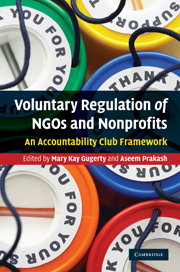Book contents
- Frontmatter
- Contents
- List of figures
- List of tables
- Notes on contributors
- Preface
- The club framework
- Part I Club emergence
- Part II Club sponsorship and club design
- 5 Nonprofit infrastructure associations as reluctant clubs
- 6 Foundation accountability clubs and the search for philanthropic standards
- 7 Do self-regulation clubs work? Some evidence from Europe and some caveats from economic theory
- 8 NGO accountability clubs in the humanitarian sector: social dimensions of club emergence and design
- Part III Club design and effectiveness
- Future research and conclusions
- Index
- References
5 - Nonprofit infrastructure associations as reluctant clubs
from Part II - Club sponsorship and club design
Published online by Cambridge University Press: 10 November 2010
- Frontmatter
- Contents
- List of figures
- List of tables
- Notes on contributors
- Preface
- The club framework
- Part I Club emergence
- Part II Club sponsorship and club design
- 5 Nonprofit infrastructure associations as reluctant clubs
- 6 Foundation accountability clubs and the search for philanthropic standards
- 7 Do self-regulation clubs work? Some evidence from Europe and some caveats from economic theory
- 8 NGO accountability clubs in the humanitarian sector: social dimensions of club emergence and design
- Part III Club design and effectiveness
- Future research and conclusions
- Index
- References
Summary
In his 1992 book, Peter Dobkin Hall argued that the nonprofit sector in the United States was “invented” in the latter half of the twentieth century (Hall, 1992). Of course, no one would assert that nonprofits did not exist before then. Indeed, they preceded the founding of the republic. What Hall meant was that the multi-industry collection of charitable and philanthropic, service, advocacy, and intermediary organizations that we now think of as the nonprofit sector in the United States developed its collective identity in that period. As Hall (1992), O'Connell (1997), Brilliant (2000), and others have documented, and as Peter Frumkin discusses in this volume (chapter 6), much of the impetus for this identity formation originated with Congressional pressure to regulate and limit the influence of foundations, ultimately leading to the building of infrastructure organizations such as Independent Sector, the Council on Foundations, academic centers like the Program on NonProfit Organizations at Yale, the Nonprofit Sector Research Fund of the Aspen Institute, and other organizations designed to coalesce common interests in defending the sector and understanding and improving its functioning. Many of these organizations take the form of associations whose members are constituent organizations that subscribe to a common set of interests or goals.
This chapter examines the evolution of two of these infrastructure associations – Independent Sector (IS) and the Nonprofit Academic Centers Council (NACC) – from the point of view of club theory.
- Type
- Chapter
- Information
- Voluntary Regulation of NGOs and NonprofitsAn Accountability Club Framework, pp. 101 - 124Publisher: Cambridge University PressPrint publication year: 2010
References
- 2
- Cited by



